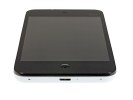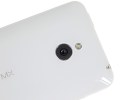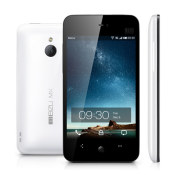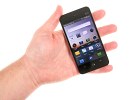This is easily a phone you can pretend doesn't exist. And you don't have to try too hard either. The Meizu MX is something of a chimera. An iPhone body and a droid mind. It's not where you take things from - it's where you take them to. For a phone coming from China, the Meizu MX has no qualms with imitation. But it's not a characterless low-cost replica either.
Strictly speaking, the Meizu MX is an Android smartphone, but it goes to great lengths to emulate the Apple iPhone in its strengths and even some of its failings. The result is a unique Android experience that differs from iOS as well - it's a very curious device, the Meizu MX.
It's hard to deny that the Chinese company went all out loading up the MX for a fight. The phone packs a 4.0" ASV LCD screen of 640 x 960 pixel resolution (the same res as the iPhone 4/4S) and an Exynos chipset straight from the Samsung Galaxy Note (a tad faster than the one in the Galaxy S II).
Impressive stuff for sure, at least when you read the features off the specs sheet. Here are the rest of them, plus the disadvantages we found:
Key features
- Quad-band GSM and penta-band 3G support
- 21.6 Mbps HSDPA and 5.76 Mbps HSUPA
- 4.0" 16M-color ASV capacitive touchscreen with 640 x 960 pixels resolution
- Heavily skinned Android OS v2.3.5 ("Flyme OS")
- 1.4 GHz dual-core Cortex-A9 CPU (currently at 1.2GHz), Mali-400MP GPU, Exynos chipset, 1GB of RAM
- 8 MP wide-angle autofocus camera with LED flash, face and smile detection; Wide Dynamic Mode
- Up to 1080p video recording @ 30fps
- Wi-Fi 802.11 b, g and n support; Wi-Fi hotspot
- GPS with A-GPS connectivity; Digital compass
- 16GB of internal storage
- Accelerometer, gyroscope and proximity sensor
- Charging MHL microUSB port with USB host, TV-out support (1080p via an optional adapter) and S/PDIF-out for dock connection
- Standard 3.5 mm audio jack
- Stereo Bluetooth v2.1
- Active noise cancellation with dedicated mic
- VGA secondary video-call camera
- Full Flash support
- Document viewer
- File manager comes preinstalled
- Extremely rich audio and video format support
- Beefy 1600 mAh battery
Main disadvantages
- Looks too much like an iPhone knockoff
- microSIM card support only
- Sub-par viewing angles and sunlight legibility
- Plastic finish of questionable quality
- No dedicated camera key (volume rocker doesn’t quite cut it)
- Non-expandable internal storage
- Battery not user replaceable
- No FM radio
It's not all perfect, but the Meizu MX can certainly go against a lot of Android flagships and show them a thing or two. But can it match the highly polished iOS experience and the trend-setting iPhone hardware?
Tough question. After using the MX for a while, you get the feeling that Meizu went trough the trouble of emulating even the downsides of the iPhone. But then you notice things that you wish iOS and vanilla Android had. The same goes for some areas of the hardware.
We're still not quite sure what to make of the Meizu MX, so this will be an interesting journey. Just try to approach it with an open mind, if you dismiss it as yet another replica, you'll miss out on an impressive (if derivative) device.
Unboxing an engineering sample box
What we have in our office is an engineering sample, which means that this isn't the retail box. Still, it should contain the same things, so here we go.
There were no surprises here really. There's a compact charger with a USB port, which is where the provided microUSB cable plugs in to charge the phone. There's also a microSIM adapter, so you can use your card from the Meizu MX in other phones easily.


A charger, USB cable and a microSIM adapter came in the box
We're not sure if there's going to be a headset in the retail box. No one seems to have one yet, so we'll have to wait for the answer of this mystery.
The Meizu MX measures 121.1 x 63.3 x 10.3 mm, which is roughly the same as the Samsung Galaxy S and slightly bigger than an iPhone 4/4S. The MX weighs 139 g.Hardware and build quality
The Meizu MX has a strong, undeniable resemblance to the iPhone - at least when you view it head on. Whether or not that resemblance was intentional doesn’t matter as differences become apparent as soon as you turn the phone over.
The MX's outer shell is made entirely of plastic and we have to say we're not big fans of it. The screen is a fingerprint magnet, while the white battery cover is much better. Still, the glossy plastic there isn't particularly pleasant to the touch.



The Meizu MX is styled to look like an iPhone, or at least its front is
The beveled edges of the back are an instant giveaway that you're dealing with something other than an iPhone 4 or 4S. There's little chance of mistaking it for a 3G/3GS either - the camera placement is very different and there's no Apple logo, of course.
The front of the device is rather iPhone-like as we said, but the 4" screen is noticeably bigger than the Retina display even if you don't have the two side by side for direct comparison.
The 640x960 pixel resolution is slightly higher than most competing droids (save for the ones with 720p screens) and with a pixel density of 288ppi it's really sharp-looking.

The screen is good on paper, but viewing angles could have been better
It's an ASV LCD unit, which in theory should provide great viewing angles, although the reality is different. Contrast loss becomes very noticeable as soon as you start turning the screen. Depending on the angle you tilt it, there's even a prominent color shift - grey turns to yellow pretty quickly.
Colors are nothing to write home about and the maximum bright ness of the screen left us wanting. Here are the brightness and contrast measurements for the display.
| Display test | 50% brightness | 100% brightness | ||||
| Black, cd/m2 | White, cd/m2 | Contrast ratio | Black, cd/m2 | White, cd/m2 | Contrast ratio | |
| HTC Salasa | 0.26 | 167 | 653 | 0.52 | 309 | 593 |
| Meizu MX | 0.17 | 123 | 740 | 0.56 | 396 | 708 |
| HTC Sensation | 0.21 | 173 | 809 | 0.61 | 438 | 720 |
| HTC Sensation XE | 0.23 | 172 | 761 | 0.64 | 484 | 752 |
| Samsung Galaxy W I8150 | 0.29 | 243 | 853 | 0.50 | 423 | 853 |
| HTC Titan | 0.26 | 233 | 891 | 0.56 | 567 | 1007 |
| Motorola RAZR XT910 | 0 | 215 | ∞ | 0 | 361 | ∞ |
| Samsung I9100 Galaxy S II | 0 | 231 | ∞ | 0 | 362 | ∞ |
| Apple iPhone 4S | 0.14 | 205 | 1463 | 0.52 | 654 | 1261 |
Moving on to the other interesting features on the front, we have a narrow slit for the earpiece and a tiny, tiny video-call camera next to it, both sitting above the screen. Ambient light and proximity sensors are also here.

Earpiece and video-call camera along with the proximity and ambient light sensors
Below the screen is where it gets interesting - the central Home key is small and rounded, protruding from the surface. That makes it easy to find by touch and it's fairly comfortable to hit, despite its small size.
On either side of it are the two capacitive soft keys. They are rather special - a patent by Meizu actually. The context aware keys change appearance and function depending on what's happening on the screen.
The left one is typically a Back key and shows a < symbol but switches to a single dot when there's nothing to come back from (it serves as a lock key in this situation, it takes a press and hold to lock).

The situation-aware capacitive keys are patented by Meizu
The right one spends most of the time as a Menu key (displaying ...) but turns into a single dot when there's no context menu available. Here it gets slightly confusing - this dot won't lock the phone if you press and hold it. Instead, it launches a heavily customized task switcher. That also works when there's a context menu - again, you press and hold to activate the task switcher.
That's not all for the soft key tricks though - the capacitive controls are haptic enabled and they actually rotate their icons to match the orientation of the screen. Also, you can adjust the brightness of their backlighting individually from the screen and when you tap a key, it pulses brighter (even if they're at the brightest setting).
Now, such keys may not seem like much, but Meizu's implementation is really cool (and one of the highlights of the MX), so we wanted to cover them in detail. You can see them on video in the User interface section of this review.
The rest of the tour will go pretty quick. The left side houses the volume keys while the right side is bare. The volume rocker is really uncomfortable - thin and quite flat.
At the top are the Power/Lock key, the 3.5mm audio jack and the secondary microphone for noise-cancellation.


Power/Lock key, 3.5mm audio jack and the secondary microphone
The bottom is home to the microUSB port and primary microphone along with two connectors that are most likely for the dock. The microUSB port serves many duties - data connection to a computer, charging, HD TV-Out over a MHL link and S/PDIF.


The microUSB port has a lot of duties
The dock sounds interesting, but there's not much info on it at the time of writing. S/PDIF is a common way to stream multi-channel digital audio, commonly found in home theater systems. If it can coexist with MHL, the Meizu MX combined with the dock can be an excellent media player option. We'll know more once details about the dock become available.
The back of the Meizu MX features the 8MP camera lens with an LED flash right next to it. The loudspeaker is also here, located at the sloping edge of the back. The loudspeaker doesn’t get muffled, but you should be careful with the camera - it can get scratched and is usually covered in fingerprints.



The back features the 8MP camera with LED flash along with the loudspeaker
The back cover can be popped open to reveal the microSIM card slot, which uses a metal tray to get the card in and out easier. You can also see the battery, but it's not user replaceable (not easily anyway), as it's wired. The battery is a 1600mAh Li-Po unit.


The non-removable battery • The microSIM card tray
The Meizu MX is comfortable to hold in the hand - it's not too big, too heavy or too thick. We wish the exterior was made of better looking plastic, but if you can get over that (or are going to use a case/pouch) there are no complaints about the build quality.
While it has its flaws, the hardware of the MX has a few tricks that can get the attention of serious buyers. Let's see if the software holds up this well - on to the interface section of this review, followed by some Exynos 4210 benchmarking.
This post sponsored by:1 Huron Street, Takapuna, North Shore 0622
Tel: (09) 551-5344 and Mob: (021) 264-0000
Web - Map - Google+ - Email - Posterous - Twitter - Blogger - Flickr - Auhtor






No comments:
Post a Comment